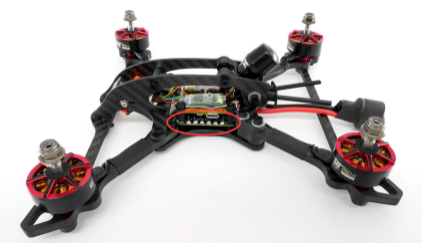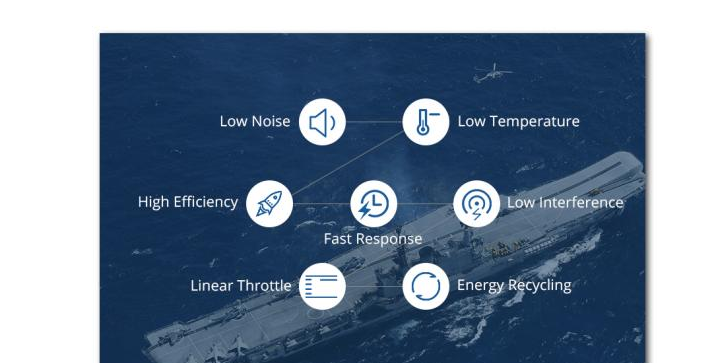A UAV propulsion system is composed of many propulsion components, such as motors, batteries, ESCs and propeller etc. ESC is one of the media of the propulsion system. The most basic function of it is to adjust the speed of the motor. Today we will talk about what exactly an ESC is, what the function of ESC’s is, and how to choose an ESC.
What is drone ESC?
ESC, the full name electronic speed controller, is referred to as ESC which is a control device that controls the engine speed. The commonly used ESC controls the PWM output through the input signal and controls the acceleration and deceleration of the motor.
According to different motors, it can be divided into brushed ESC and brushless ESC. The ESC receives the signal from the flight controller to control the start, stop the motor. It receives the signal to control the on-off of each power tube of the inverter bridge.
What does an ESC do on a drone?
An ESC can also be taken as the intermediary that connects the various components of the drone like a brain to control your main body. It has some irreplaceable functions:
1.Control motor’s speed: The so-called ESC can also be compared to a voltage regulator, which can convert the input power to different voltages by receiving PWM signals, and output them to the motor, so as to achieve the purpose of making the motor generate different speeds.
2.Change the motor’s rotating direction: A brushed ESC can change the direction of the current so that the direction of the motor rotation can be changed.
3.Convert three-phase electricity: A brushless ESC can convert the input DC into three-phase AC to power the motor, and control the voltage and current of the motor according to the control signal sent by the flight controller, so as to drive the motor to achieve the required speed output.
The role of the electronic governor is to balance the cooperation between the battery and the motor. As a load-carrying intermediary, it prevents the huge current brought by the battery to the motor, which causes flight hazards caused by abnormal rotation.

Different types of ESC?
If you are a newcomer to the drone world, your eyes may be messed up by various types of ESCs in the market since there are really lots of options. Therefore, this section is mainly to introduce you to the mainstream types of drone ESCs from the market.
The differences among ESCs not only lies in structures, but also in control methods.
1.Structures
For small drones like FPV on the market, the appearance of ESCs can be divided into two forms. One is a single ESC (Picture 1), and the other is a 4 in 1 ESC (Picture 2)


Picture 1 Picture 2
A single ESC: a small UAV usually consists of four motors, so four ESCs are required on one model. That is: one ESC drives one motor. The advantage of single ESC is that it can be replaced separately if damaged, which is relatively easy to maintain low cost and simple maintenance.

A 4 in 1 ESC: as the name suggests, the 4-in-1 ESC integrates four separate ESCs . There is no essential difference in function from the single ESC. The advantages of the 4 in 1 ESC lie in the convenience in assembly and simplicity in wiring.

2.ESC with BEC or OPTO ESC without BEC
There are two types of ESCs commonly used in multi-rotor drones. One is the ESC with BEC, and the other is the OPTO ESC without BEC.
On the outside of some ESCs, you will see words such as BEC. The full name of this BEC is the battery elimination circuit. That is to say, there is a separate circuit module in the ESC. This circuit module can convert the voltage of the battery into 5-6V voltage to supply power to the receiver or flight control.

3.Control methods
In some larger drones, there are ESCs with different control methods: Square wave drive ESC and sine wave drive ESC.
3.1 Square wave drive ESC uses PWM modulation technique to control the motor. The control method mainly solves two problems: commutation of windings and voltage regulation. The commutation logic signal and the voltage regulation signal are modulated together to obtain the PWM control signal, which is used to realize the control of the BLDC motor.
The square wave ESC features simple control and low cost, and is widely used in the field of multi-rotor UAVs. However, the output torque of the BLDC motor driven by the square wave ESC is large, the dynamic response speed is limited. At the same time it is susceptible to stall problems during high-speed operation.
3.2 Sine wave drive ESC ,with a BLDC motor as the carrier.The sine wave drive ESC uses SPWM modulation technology to implement control of the BLDC motor. This control method improves the utilization of the three-phase windings of the BLDC motor and can eliminate the commutation torque pulsation and stalling problems when the two motors are turned on.
The application on a multirotor UAV shows that using sine waves to drive the ESC makes the UAV more stable.
At present, sine wave has evolved to a new generation, namely FOC (Field Oriented Control). The FOC ESC uses SVPWM modulation technology to control the PMS motor to generate a circular rotating magnetic field. Vector control can achieve smooth control of motor speed and torque. At the same time, compared with SPWM modulation, the utilization ratio of DC bus voltage is about 15% higher than SVPWM modulation.

How to choose ESC for drone?
First of all, it would be necessary to figure out the order of choosing an ESC.
As mentioned in the first section, ESC is the medium that conducts and controls current in batteries and motors.Therefore, only by coordinating the relationship between these three parts, the system can offer the best performance. Otherwise, it may cause damage to your drone.
Remember this selection order: Motor -ESC-Battery.
1. Current: The rated current of the ESC is usually marked in the most conspicuous position, and the format is a number plus a unit A.
Usually, this value corresponds to the working current of the motor. In an ordinary way, we will take the power under the maximum throttle of the motor as a reference. If a motor's current under 100% throttle is 26A, then you should choose at least a 30A ESC. But for safety, we recommend you use a larger ESC increasing the value by about 10%-20%.

2. Voltage: the voltage of the ESC is determined by the output of the battery, so the voltage of the battery must be equal to or less than the acceptable range of the ESC
Remember the principles of battery and ESC:
2.1 The battery voltage cannot exceed the maximum load voltage of the ESC. If the ESC display 2-6s, then you can't choose a battery voltage lager than 6s.
2.2 The continuous output of the battery current must be greater than the maximum continuous current output of the ESC.

Other factors to consider when choosing an ESC
3. Size and weight: Even with the same value of output current, the appearance, size and weight of different ESCs may be different. Racing drones usually require ESC which are lighter and smaller for fast response rate. But there is a problem with such ESCs if you are to increase the current. Such ESCs are not good in cooling performance. That is why larger UAVs tend to be equipped with larger and heavier ESCs for better heat dissipation to keep the whole system working properly.
4. PWM signal: The full name of PWM is Pulse-width modulation. The frequency of the PWM signal is usually not specified, and it can be 50hz, 100hz, 200hz or 500hz and so on. The higher the control frequency, the shorter the cycle, the shorter the control interval, and the faster the response speed of the ESC and motor. Conversely, the lower the control frequency, the longer the cycle, the longer the control interval, and the slower the response speed of the ESC and the motor. With the development of technology and the requirements for smooth control, most ESCs now support more than 500hz. The PWM signal, and the ESC has its own filter, which can respond well and control the rotation of the motor.
If you want to have a fast response ESC, please focus on this parameter.
How to connect drone ESC to motor?
The connection between the ESC and the motor and the flight controller is generally as follows:
1. The input wires of the ESC (the thickest red and black wire) are connected to the battery;
2. The output wires of the ESC connected to the motor;
3. The signal wire (the thinnest wire) of the ESC is connected to the flight controller.
About how to connect drone ESC to motor: Drone ESC Wires Instruction
How to calibrate drone ESC?
Normally startup process:
1. Wiring Diagram
2. Throttle Range Calibration:
2.1 Turn on the transmitter and push the throttle stick to the top position
2.2 Connect the receiver to the battery, ensure the transmitter and receiver are well bound, turn on the ESC
2.3 After the motor emits two shorts”beep beep”push the throttle stick to the bottom position within 3 seconds, and motor emits a long “beep”.
2.4 Throttle calibration completed.
3. ESC programming
3.1 Turn on the transmitter and push the throttle stick to the top position
3.2 Connect the receiver to the battery, ensure the transmitter and receiver are well bound, turn on the ESC
3.3 The motor will beep different tones circularly
3.4 Move the throttle stick to the bottom position in 3 seconds after the corresponding beeps, then the programming item is set
3.5 Programming is completed.
ESC troubleshooting
| Warning tone | Warning tone | Solution |
| “Beep beep beep…”the motor beep rapidly | The throttle is not adjusted to the lowest position or the stroke setting is too small | Push the throttle to the lowest point or recalibrate the throttle stroke |
| “Beep、beep、beep…”(time interval is 1 second) | No throttle output signal | Check whether the cooperation between the transmitter and the receiver is normal, and whether the wiring of the throttle control channel is working normally |
| “Beep beep、beep beep…”(these tones are placed circularly) | The voltage is low | Replace normal voltage battery |
| “beep beep beep、beep beep beep、”(these tones are played circularly) | The voltage is high | Replace normal voltage battery |
FAQ
Does every drone ESC have the protections?
Not all ESCs have protection mechanisms. Here are some common protections with ESCs:
1. Start-up Protection
2. Throttle Signal Loss Protection
3. Motor Lock-up Protection
4. Over-load Protection
Where to buy drone ESC?
Search ESC, you will see many options. It is always safer to buy the mainstream brands. Purchases usually can be made directly through the online official store like www.tmotor.com. T-MOTOR also have many distributors for easy access of the customers to buy locally.
How much is a drone ESC?
Pricing varies according to its materials, performance and control methods. It also varies according to applications. For example, ESCs used in industrial drones will usually be more expensive than those for model planes and FPV drones.
